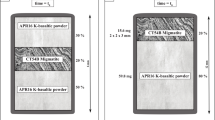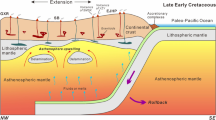Abstract
Rarely occurring clinopyroxene-plagioclase bearing, felsic granulite and skarn xenoliths were studied from the mantle and crustal xenolith-bearing alkaline basaltic and pyroclastic localities of the Bakony–Balaton Highland Volcanic Field (W-Hungary). Geobarometry and geothermometry of the xenoliths made it possible to categorise them in three groups according to their depth of formation. The first group formed in the lower crust together with mafic and metasedimentary granulites. The second group represents magmatic intrusions of the middle crust, and the third one comprises contact metamorphic rocks of relatively shallow origin. The calculated pressure difference from the core and rim compositions of plagioclase and clinopyroxene as well as garnet breakdown reactions in some xenoliths show evidence for pressure decrease due to crustal thinning both in lower crustal and middle crustal xenoliths during formation of the Pannonian Basin. Fluid inclusion studies reveal the dominance of the CO2-rich fluids in the whole crustal section in contrast with fluids found in mafic garnet-bearing xenoliths. Crustal stratigraphy was constructed for the periods prior to the extension and after the extension on the basis of geobarometry and geophysical data. On the basis of mineral stabilities and geothermo-barometry, we estimated that the pre-extensional thickness of the lower and upper crust may have been 27–34 and 26–28 km, respectively. Comparison of pre-extensional and present-day thickness of the lower and upper crust indicate that thinning affected both the lower and the upper portion of the crust but on a different scale. The calculated thinning factors are between 2.25 and 3.4 for the lower crust and 1.3–1.56 for the upper crust.










Similar content being viewed by others
References
Bali E, Szabó C, Vaselli O, Török K (2002) Significance of silicate melt pockets in upper mantle xenoliths from the Bakony–Balaton Highland Volcanic Field, Western Hungary. Lithos 61:79–102
Balogh K, Árva-Sós E, Pécskay Z (1986) K/Ar dating of post-Sarmatian alkali basaltic rocs in Hungary. Acta Miner Petrogr Szeged 28:75–93
Berkesi M, Hidas K, Szabó C (2007) Fossile geotherm estimation of spinel peridotite xenoliths from Tihany (Bakony–Balaton Highland Volcanic Field) based on CO2 fluid inclusions. Magyar Geofizika 48:31–38
Bhowmik SK, Roy A (2003) Garnetiferous metabasites from the Sausar mobile belt: petrology, P-T path and implications for the tectonothermal evolution of the Central Indian tectonic zone. J Petrol 44:387–420
Brown PE (1989) FLINCOR: a microcomputer program for the reduction and investigation of fluid-inclusion data. Am Miner 74:1390–1393
Brown PE, Lamb WM (1989) P-V-T properties of fluids in the system H2O–CO2–NaCl: new graphical presentations and implications for fluid inclusion studies. Geochim Cosmochim Acta 53:1209–1221
Cesare B (2000) Incongruent melting of biotite to spinel in a quartz-free restite at El Joyazo (SE Spain): textures and reaction characterization. Contrib Miner Petrol 139:273–284
Dégi J, Badenszki E, Török K, Kodolányi J, Szép A, Marosi G (2005) Detailed study of the CO2–CO ± C system in mafic granulite xenoliths from Bakony–Balaton Highland Volcanic Field central Pannonian Basin, W-Hungary. ECROFI XVIII. Siena, 6–9 July 2005 Abstract e-book, 05 Degi.pdf
Dégi J, Abart R, Török K, Rhede D, Petrishcheva E (2009) Evidence for xenolith—host basalt interaction from chemical patterns in Fe–Ti-oxides from mafic granulite xenoliths of the Bakony–Balaton Volcanic field (W-Hungary). Miner Petrol 95:219–234. doi:10.1007/s00710-008-0035-0
Dégi J, Abart R, Török K, Bali E, Wirth R, Rhede D (2010) Symplectite formation during decompression induced garnet breakdown in lower crustal mafic granulite xenoliths: mechanisms and rates. Contrib Miner Petrol 159:293–314. doi:10.1007/s00410-009-0428-z
Dobosi G, Downes H, Embey-Isztin A, Jenner GA (2003a) Origin of megacrysts and pyroxenite xenoliths from the Pliocene alkali basalts of the Pannonian Basin (Hungary). Neues Jb Miner Abh 178:217–238
Dobosi G, Kempton P, Downes H, Embey-Isztin A, Thirlwall M, Greenwood P (2003b) Lower crustal xenoliths from the Pannonian Basin, Hungary. Part 2: Sr-Nd-Pb-Hf and O isotope evidence for formation of continental lower crust by tectonic emplacement of oceanic crust. Contrib Miner Petrol 144:671–683
Downes H, Embey-Isztin A, Thirlwall MF (1992) Petrology and geochemistry of spinel peridotite xenoliths from Hungary: evidence for an association between enrichment and deformation in the mantle. Contrib Miner Petrol 109:340–354
Elkins LT, Grove TL (1990) Ternary feldspar experiments and thermodynamic models. Am Miner 75:544–559
Ellis D (1978) Stability and phase equilibria of chloride and carbonate bearing scapolites at 750 C and 4000 bar. Geochim Cosmochim Acta 42:1211–1281
Embey-Isztin A, Scharbert HG, Dietrich H, Poultidis H (1989) Petrology and geochemistry of peridotite xenoliths in alkali basalts from the Transdanubian Volcanic Region, West Hungary. J Petrol 30:79–105
Embey-Isztin A, Scharbert HG, Dietrich H, Poultidis H (1990) Mafic granulites and clinopyroxenite xenoliths from the Transdanubian Volcanic Region (Hungary): implications for the deep structure of the Pannonian Basin. Min Mag 54:463–483
Embey-Isztin A, Downes H, James DE, Upton BGJ, Dobosi G, Ingram G, Harmon RS, Scharbert HG (1993) The petrogenesis of Pliocene alkaline volcanic rocks from the Pannonian Basin, Eastern Central Europe. J Petrol 34:317–343
Embey-Isztin A, Downes H, Kempton PD, Dobosi G, Thirwall M (2003) Lower crustal granulite xenoliths from the Pannonian Basin, Hungary. Part 1: mineral chemistry, thermobarometry and petrology. Contrib Miner Petrol 144:652–670
Gasparik T, Newton RC (1984) The reversed alumina contents of orthopyroxene in equilibrium with spinel and forsterite in the system MgO–Al2O3–SiO2. Contrib Miner Petrol 85:186–196
Goldschmidt JR, Newton RC (1977) Scapolite-plagioclase stability relations at high pressures and temperatures in the system NaAlSi3O8–CaAl2Si2O8–CaCO3–CaSO4. Am Miner 62:1063–1080
Guernina S, Sawyer EW (2003) Large-scale melt-depletion in granulite terranes: an example from the Archean Ashuanipi subprovince of Quebec. J Metam Geol 21:181–201
Herzberg CT (1978) Pyroxene geothermometry and geobarometry: experimental and thermodynamic evaluation of some subsolidus phase relations involving clinopyroxenes in the system CaO–MgO–Al2O3–SiO2. Geochim Cosmochim Acta 42:945–957
Horváth F (1993) Towards a mechanical model for the formation of the Pannonian basin. Tectonophys 226:333–357
Huismans RS, Podladchikov YY, Cloetingh S (2001) Dynamic modeling of the transition from passive to active rifting, application to Pannonian basin. Tecton 20:1021–1039
Irving AJ (1974) Geochemical and high-pressure experimental studies of garnet pyroxenite and pyroxene granulite xenoliths from the Delegate Basaltic pipes, Australia. J Petrol 15:1–40
Krogh EJ (1988) The garnet-clinopyroxene Fe-Mg geothermometer—a reinterpretation of existing experimental data. Contrib Miner Petrol 99:44–48
Kushiro I, Yoder HS (1966) Anorthite—forsterite and anorthite—enstatite reactions and their bearing on the basalt—eclogite transformation. J Petrol 7:337–362
McCarthy TC, Patiño-Douce AE (1998) Empirical calibration of the silica-Ca-tschermak’s-anorthite (SCAn) geobarometer. J Metam Geol 16:675–686
Mituch E, Posgay K (1972) The crustal structure of Central and Southeastern Europe on the results of explosion seismology; Hungary. Geophys Transactions Spec Ed. Eötvös Loránd Geofizikai Intézet, Budapest, pp 118–131
Moecher DP, Essene EJ (1990) Phase equilibria for calcic scapolite, and implications of variable Al-Si disorder for P-T, T-XCO2, and a-X relations. J Petrol 31:997–1024
Neogi S, Dasgupta S, Fukuoka M (1998) High P-T polymetamorphism, dehydration melting, and generation of migmatites and granites in the higher himalayan crystalline complex, Sikkim, India. J Petrol 39:61–99
Newton RC, Goldschmidt JR (1976) Stability of the end-member scapolites: 3NaAlSi3O8 NaCl, 3CaAl2Si2O8 CaCO3, 3CaAl2Si2O8 CaSO4. Zeitschrift Kristallog 143:333–353
Orville PM (1975) Stability of scapolite in the system Ab–An–NaCl–CaCO3, at 4 kb and 750 C. Geochim Cosmochim Acta 39:1091–1105
Pattison DRM, Chacko T, Farquhar J, McFarlaine CRM (2003) Temperatures of granulite-facies metamorphism: constraints from experimental phase equilibria and thermobarometry corrected for retrograde exchange. J Petrol 44:867–900
Posgay K, Albu I, Petrovics I, Ráner G (1981) Character of the earth’s crust and upper mantle on the basis of seismic reflection measurements in Hungary. Earth Evol Sci 3–4:272–279
Posgay K, Albu I, Mayerova M, Nakladalova Z, Ibrmajer I, Blizkovski M, Aric K, Gutdeutsch R (1991) Contour map of the Mohorovicic discontinuity beneath Central Europe. Geophys Trans 36:7–13
Poty B, Leroy J, Jachimowicz L (1976) Un nouvel appareil pour la measure temperat es sous le microscope. Bull Miner 99:182–186
Satish-Kumar M, Santosh M, Harley SL, Yoshida M (1996) Calc-silicate assemblages from Kerala Khondalite Belt, southern India: Implications for pressure-temperature-fluid histories. J Southeast Asian Earth Sci 14:245–263
Soto JI, Soto VM (1995) PTMAFIC: software package for thermometry, barometry and activity calculations in mafic rocks using an IBM compatible computer. Comp Geosci 21:619–652
Spear FS (1981) An experimental study of hornblende stability and compositional variability in amphibolites. Am J Sci 281:697–734
Stegena L, Géczy B, Horváth F (1975) Late Cenozoic evolution of the Pannonian Basin. Tectonophys 26:71–90
Szabó CS, Harangi SZ, Csontos L (1992) Review of Neogene and Quaternary volcanism of the Carpathian-Pannonian Region. Tectonophys 208:243–256
Szabó C, Harangi S, Vaselli O, Downes H (1995) Temperature and oxygen fugacity in peridotite xenoliths from the Carpatho-Pannonian Region. In: Downes H, Vaselli O (eds) Neogene and related magmatism in the Carpatho-Pannonian region. Acta Volcanol 7:231–239
Szafián P, Tari G, Horváth F, Cloetingh S (1999) Crustal structure of the Alpine–Pannonian transition zone: a combined seismic and gravity study. Int J Earth Sci 88:98–110
Török K (1995) Garnet breakdown reaction and fluid inclusions in a garnet clinopyroxenite xenolith from Szentbékkálla (Balaton Highland, W-Hungary). In: Downes H, Vaselli O (eds) Neogene and related magmatism in the Carpatho-Pannonian region. Acta Volcanol 7:285–290
Török K (2002) Ultrahigh-temperature metamorphism of a buchitised xenolith from the basaltic tuff of Szigliget (Hungary). Acta Geol Hung 45:175–192
Török K, De Vivo B (1995) Fluid inclusions in upper mantle xenoliths from the Balaton Highlands, W-Hungary. In: Downes H, Vaselli O (eds) Neogene and related magmatism in the Carpatho-Pannonian region. Acta Volcanol 7:277–285
Török K, Bali E, Szabó C, Szakál JA (2003) Sr-barite droplets associated with sulfide blebs in clinopyroxene megacrysts from basaltic tuff (Szentbékkálla, Western Hungary). Lithos 66:275–289
Török K, Dégi J, Marosi G, Szép A (2005) Reduced carbonic fluids in mafic granulite xenoliths from the Bakony–Balaton Highland Volcanic Field, W-Hungary. Chem Geol 223:93–108. doi:10.1016/j.chemgeo.2005.05.010
Vielzeuf D, Schmidt MW (2001) Melting relations in hydrous systems revisited: application to metapelites, metagreywackes and metabasalts. Contrib Miner Petrol 141:251–267
Wells PRA (1977) Pyroxene thermometry in simple and complex systems. Contrib Miner Petrol 62:129–139
Wenzel T, Baumgartner LP, Brügman GE, Konnikov EG, Kislov EV (2002) Partial melting and assimilation of dolomitic xenoliths by mafic magma: The Ioko-Dovyren intrusion (North Baikal Region, Russia). J Petrol 43:2049–2074
Wijbrans J, Németh K, Martin U, Balogh K (2007) 40Ar/39Ar geochronology of Neogene phreatomagmatic volcanism in the western Pannonian Basin, Hungary. J Volcanol Geotherm Res 164:193–204. doi:10.1016/j.jvolgeores.2007.05.009
Acknowledgments
The author gratefully acknowledges the financial help of the National Scientific Research Fund (OTKA, NN79943) and the Bolyai grant of the Hungarian Academy of Sciences. The author also acknowledges constructive criticism of the referees, B. Cesare, A. van den Kerkhof, and B. DeVivo which helped to improve the manuscript.
Author information
Authors and Affiliations
Corresponding author
Rights and permissions
About this article
Cite this article
Török, K. On the origin and fluid content of some rare crustal xenoliths and their bearing on the structure and evolution of the crust beneath the Bakony–Balaton Highland Volcanic Field (W-Hungary). Int J Earth Sci (Geol Rundsch) 101, 1581–1597 (2012). https://doi.org/10.1007/s00531-011-0743-2
Received:
Accepted:
Published:
Issue Date:
DOI: https://doi.org/10.1007/s00531-011-0743-2




